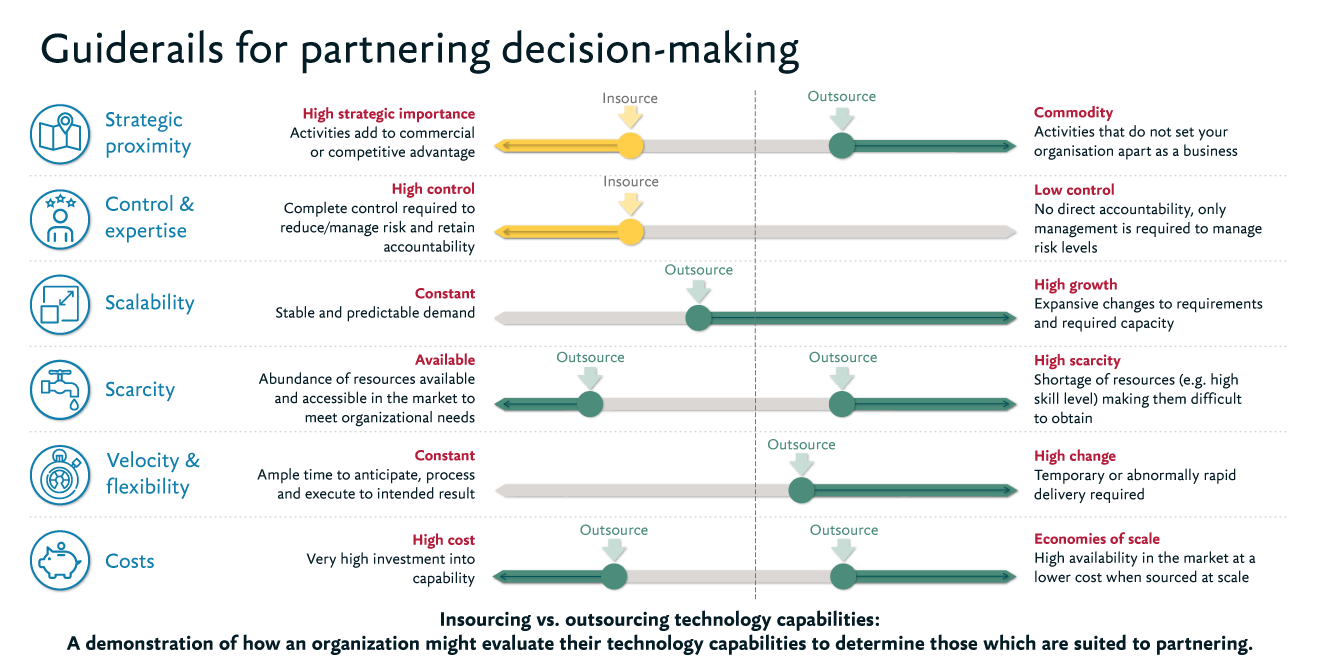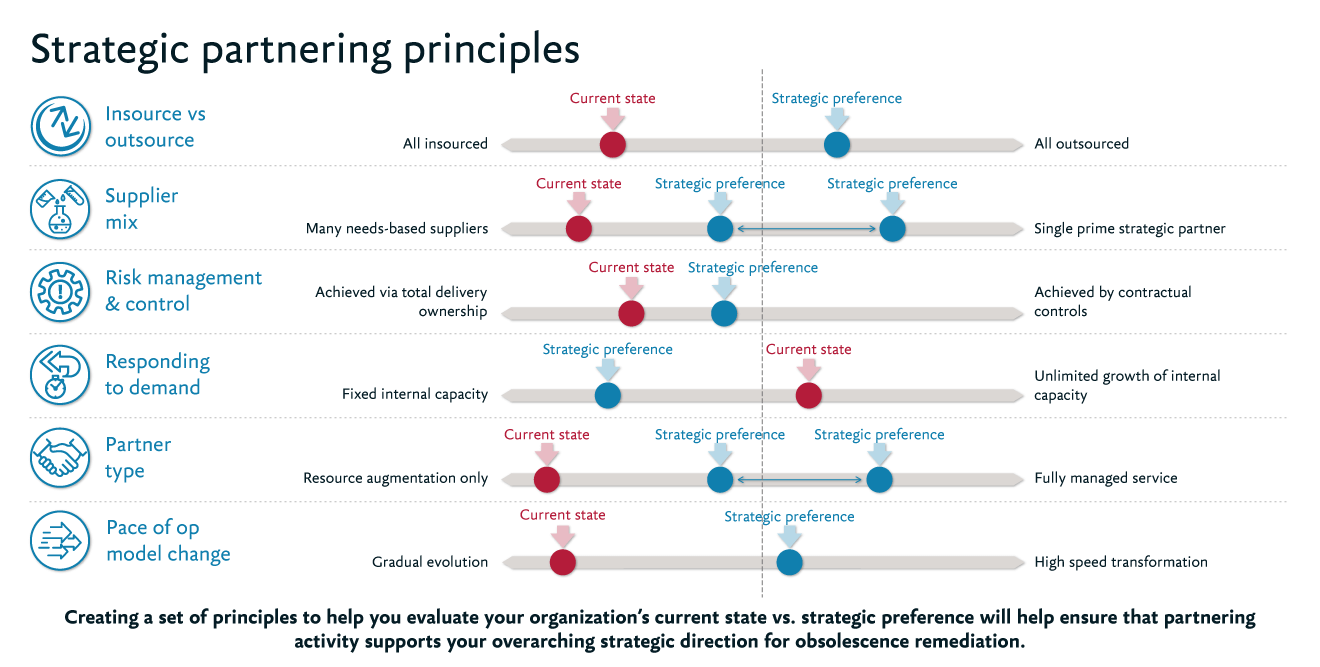Insight
Smart tech partnering: Buying intelligently on the journey from legacy to leading-edge
Are you struggling to secure the tech skills needed to sustain ‘mission critical’ operations and tackle the obsolescence risks in your legacy estate? Tapping into new and expanding partnership opportunities could provide an answer as the tech supplier USP shifts from simply cutting costs to helping to boost capacity and capabilities. How can you make the most of the potential?
In a previous article in this series, we looked at the significance of enterprise architecture and operating models in aligning your tech capabilities with the strategic ambitions of your organization. One of the key considerations for your target operating model is defining your approach to partnering, but why is this so important?
Technology and supplier landscape evolution
Over the last couple of decades, there has been a shift in technology trends, and a resulting change to the tech supply chain landscape. The historical model of owning and running infrastructure internally but outsourcing technology development has flipped; many leaders now strive to build high performing internal development teams and rely on third parties for provision of infrastructure and platform services upon which their products can run. Over time, this has led to the flattening of the technology supply chain as platform providers have expanded the breadth of their offer to include the underlying infrastructure and has paved the way for subscription-based service models. This means that it’s generally the service provider’s job to make sure that your tech is continually maintained, relieving you of the obsolescence risk.
Wide ranging technology expertise
Technology providers can help you to overcome the challenges of securing crucial personnel who know how legacy systems work and how to maintain them where key in-house personnel may have left or be approaching retirement. They can also provide access to leading-edge knowledge on newer technology solutions when this is not present internally and without which, modernization efforts are likely to stall. For technology leaders, this access to scarce or hard-to-attract talent is now the primary strategic driver to ‘outsource’; a significant shift from the previous focus on cost cutting.
Access to modernisation-critical skills
Alongside the latest tech, partnering offers access to high maturity digital and change management skills, as well as to the agile working practices synonymous with modern tech solutions. This extra support can be especially crucial when embarking on major modernization, where the ‘bow wave’ of activity required can be derailed by capacity or capability gaps. Partners can help bridge these gaps – the people to implement as well as operate the new systems – with many providers offering time-flexible contracts that can run from initial support in shaping technical solutions or delivery approaches, delivering the technology change for you in the form of ‘build and hand back’, all the way to long-term operation via a managed service as required.
One size does not fit all
Partnering can be perceived as potentially risky in some sectors. For example, some organizations providing critical national infrastructure or operating in sensitive sectors such as defence, may be reluctant to use managed service companies operating offshore. Considerations regarding cyber security and the protection of sensitive data play a part. However, many large service providers are responding to such concerns by bringing operations onshore, either within the UK or European Union.
Three ways to make the most of the partnership potential
With partnership opportunities come challenges, from selecting the right suppliers and managing relationships to building third-party support into your operating model and wider strategy. How then can you make partnering work for your organization’s specific needs? Drawing on our experience of helping clients to strengthen their partnering strategies, tech procurement and partner management capabilities, three priorities stand out:
1. Evaluate where partnership could provide the best option
The starting point for smart tech partnering is pinpointing which of your tech capabilities and modernization programs are most suited to outside support and which are not. This will help you to define the scale of the partnering opportunity that exists across your tech landscape.

Assessing your key capabilities and modernization programs through this framework is likely to result in a mix of insource and outsource recommendations; outsourcing won’t be the right answer in all cases. Some of the capabilities you have will be so unique to your organization, so strategically valuable or so highly sensitive, that they can only be delivered as a bespoke in-house option; recognizing and planning for this is key.
Once the scale of the partnering opportunity has been defined, it’s crucial to align on the strategic principles that will shape your approach to this. These principles should be tailored to your organization and should be informed by both your strategic objectives for addressing obsolescence balanced with the preferences and aspirations for your technology operating model.

2. Take advantage of your buying power for partnering
It is important to understand, organize and plan your sourcing activities in a way that maximizes value to your organization. Some organizations don’t always realise the value of their buying power, which can be compounded by fragmented purchasing and this is particularly prevalent in public sector. It is common practice in large private sector organisations to have category-specific buying operating models supported with specialist capabilities, yet the public sector largely relies on a generalist model. While pockets of digital and data procurement expertise exist, buying is typically performed by generalists with limited use of more strategic approaches such as category management.
Consolidating purchasing as part of a category management plan can not only help to generate savings through negotiation of volume discounts but can also provide better visibility of total cost of ownership across each category which supports better decision making, enables streamlined procurement as part of wider operational efficiencies and can help to ensure your purchasing activities remain aligned to your strategic objectives.
3. Grow your intelligent client capabilities
Critical to the success of any new partnering strategy is having the right level of expertise and skills internally to effectively deliver upon it. Increasingly, organizations are recognising the importance of an ‘intelligent client’ capability - a highly skilled multi-disciplinary team who will thoroughly scope and rigorously select the right partners, as well as robustly manage supplier activities to reduce risk, maximise efficiency and deliver value for money once partners are in place.
Priorities don’t just include driving a hard bargain financially. It’s also important to ensure that procurement activities consider the appropriate service levels and scope for change needed to keep pace with tech developments and evolving demands. Strategic partnerships may also make provisions for ‘value add’ activities such as support for innovation agenda or advisory on complex technical or delivery challenges. Ongoing activities once partners are selected will focus on relationship management and ensuring the required outcomes are met.
If this is an area where your organization struggles today, it’s important to remember that maturing your capability can take time and it may be necessary to bring in specialist outside support while building up the necessary skills in-house. You should plan the phasing of your partnering strategy implementation to align to your evolving intelligent client capability. Put simply, don’t run before you can walk. A negative outcome on a large scale and high value partnering arrangement due to poor execution of procurement or lack of ongoing client-side management can be costly and time consuming to rectify and will only set you back in achieving your strategic objectives.
Moving to a new normal
While partnering isn’t a universal panacea, it could help you in easing some of your obsolescence risks along your journey from legacy dominated towards leading-edge technology.
In the final article in this series, we look at how to build developments in tech delivery models in areas such as partnering into a ‘new normal’ portfolio management approach to systems operation and optimization.
Let’s talk
We’re working with businesses across all sectors to help them sustain operations and cut through the complexities of legacy tech transformation. Contact us if you’d like to know more.










